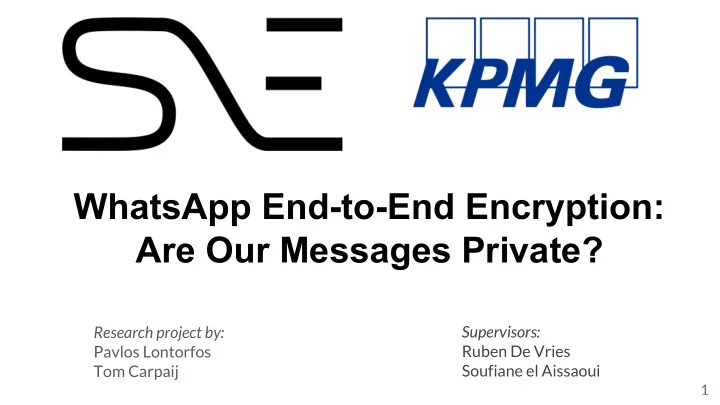

WhatsApp End-to-End Encryption: Are Our Messages Private? Supervisors: Research project by: Pavlos Lontorfos Ruben De Vries Soufiane el Aissaoui Tom Carpaij 1
Introduction 2
Introduction 1.5 billion users ● “Black box” application ● Security vs. end-to-end encryption ● Can we trust Facebook's claim of End-to-End ● encryption? 3
Research questions Is user-to-user message exchange via WhatsApp End-to-End encrypted? What are the algorithms used to create the Signal protocol? ● What are the differences between Signal and WhatsApp network traffic? ● To what extent are WhatsApp messages encrypted to the Signal protocol ● specifications? 4
Literature review Breach of End-to-End encryption in group messages [1] ● Non-blocking WhatsApp implementation [2] ● Voicemail account verification hijack [3] ● Signal protocol papers [4] [5] ● WhatsApp End-to-End encryption implementation whitepaper [6] ● Formal proof of Signal protocol security [7] ● 5
Background: Extended Triple Diffie-Hellman (X3DH) X3DH illustration. From Open Whisper Systems , by Marlinspike and Perrin, 2016. Retrieved from https://signal.org/docs/specifications/x3dh/ 6
Background: Single ratchet algorithm Single ratchet illustration. From Open Whisper Systems , by Perrin and Marlinspike , 2016. Retrieved from https://signal.org/docs/specifications/doubleratchet/ 7
Background: Double ratchet algorithm Double ratchet illustration. From Open Whisper Systems , by Perrin and Marlinspike , 2016. Retrieved from https://signal.org/docs/specifications/doubleratchet/Set3_2.png 8
Blocking-Non blocking mechanism Signal: Blocking Mechanism No message retransmission ● Smaller User Base ● Secure ● WhatsApp: Non-blocking Mechanism Messages are retransmitted ● Friendly user experience/ convenience ● Security issues - Attack scenario ● 9
Methods Assumptions made: If Signal is implemented correctly, the protocol is secure ● Signal Application implements their protocol correctly ● WhatsApp is proprietary software Android version was analyzed. Protocol implementation remains the same for IOS Latest available version of WhatsApp(2.18.380) and Signal(4.32.8) 10
Experiments 11
Experiment: Traffic comparison 12
Results: Traffic comparison 13
Experiment: Packet decryption 14
Results: Packet decryption 15
Results: Packet decryption 16
Results: Packet decryption Unfortunately no packets captured from WhatsApp Noise Pipes : Custom protocol instead of TLS Burp Suite couldn’t recognise those packets 17
Experiment: Basic blocking 18
Experiment: Basic blocking 19
Experiment: Basic blocking 20
Experiment: Basic blocking 21
Experiment: Basic blocking 22
Experiment: Basic blocking 23
Experiment: Basic blocking 24
Results: Basic blocking 25
Experiment:Sender offline blocking 26
Experiment:Sender offline blocking 27
Experiment:Sender offline blocking 28
Experiment:Sender offline blocking 29
Experiment:Sender offline blocking 30
Results: Sender offline blocking 31
Experiment:Sender offline blocking 32
Experiment: Sender offline blocking 33
Results: Sender offline blocking 34
Experiment: Sender migration blocking 35
Results: Sender migration blocking 36
Discussion We expected the traffic of both applications to be more similar ● Decryption could verify the correct use of the Signal protocol ● 37
Future work Key extraction and message decryption (reverse engineering) ● Phone call verification abuse ● Metadata collection ● WhatsApp, Instagram and Messenger integration ● 38
Conclusion What are the algorithms used to create the Signal protocol? ● What are the differences between Signal and WhatsApp network ● traffic? To what extent are WhatsApp messages encrypted to the Signal ● protocol specifications? Is user-to-user message exchange via WhatsApp end-to-end encrypted? Probably yes 39
References ● [1] P. R ̈osler, C. Mainka, and J. Schwenk, “More is less: On the end-to-end security of group chats in signal, whatsapp, and threema,” 2018. ● [2] M. Marlinspike, “ There is no WhatsApp ’backdoor’),” 2017, last accessed 22 January 2019. [Online]. Available: https://signal.org/blog/there-is-no-whatsapp-backdoor/ ● [3] M. Vigo, “Compromising online accounts by cracking voicemail systems),” 2018, last accessed 21 January 2019. [Online]. Available: https://www.martinvigo.com/voicemailcracker/ ● [4] K. Cohn-Gordon, C. Cremers, B. Dowling, L. Garratt, and D. Stebila, “A formal security analysis of the signal messaging protocol,” in Security and Privacy (EuroS&P), 2017 IEEE European Symposium on. IEEE, 2017, pp. 451–466. ● [5] WhatsApp, “Whatsapp encryption overview,” April 5, 2016, p. 12. 40
Recommend
More recommend